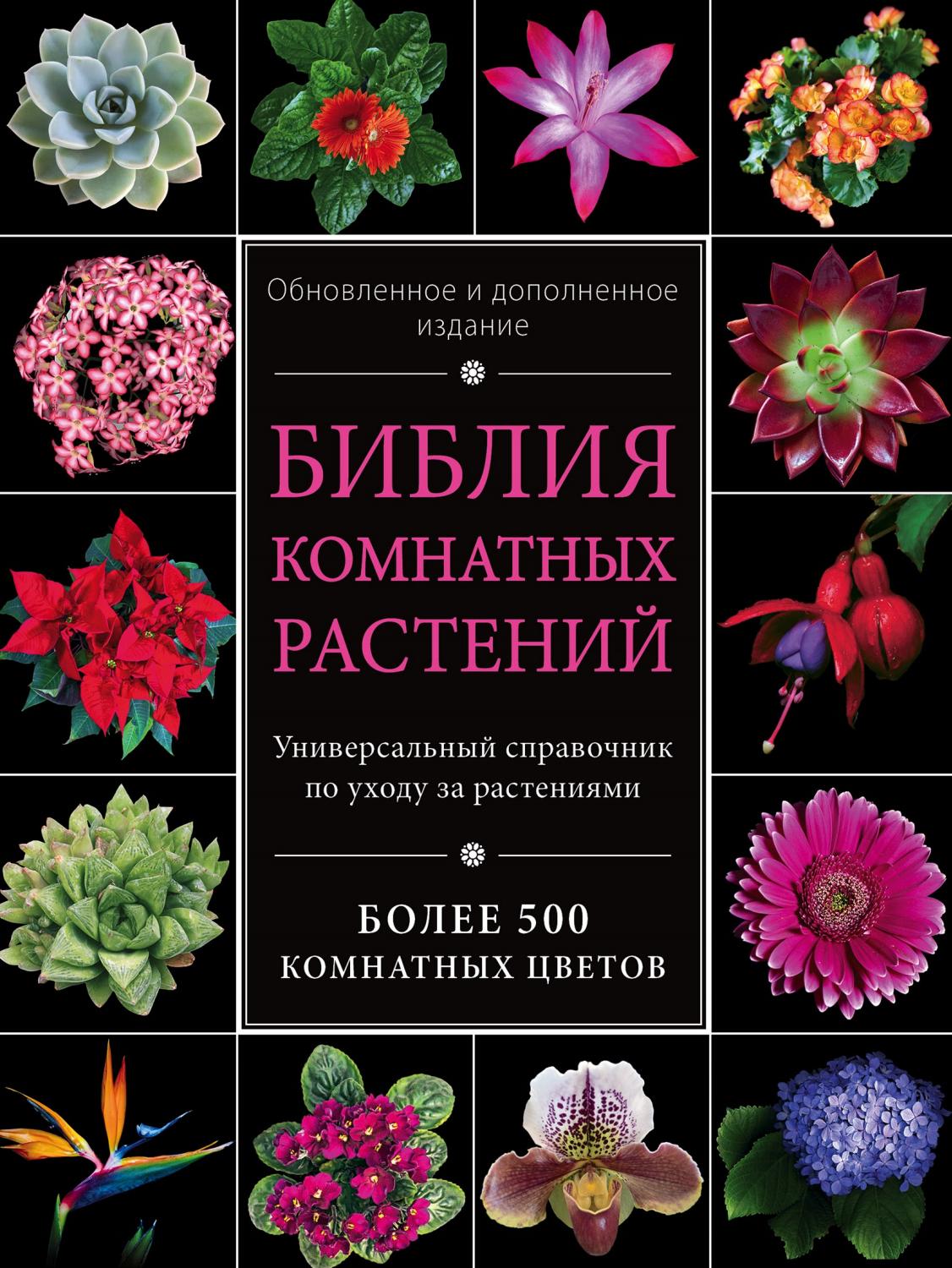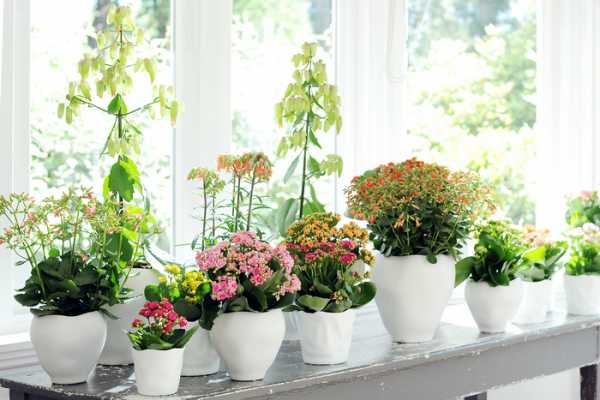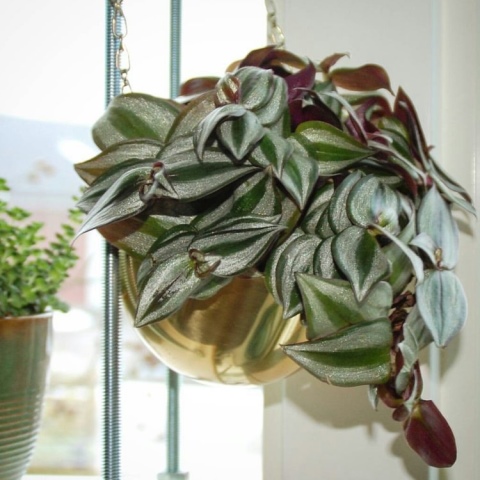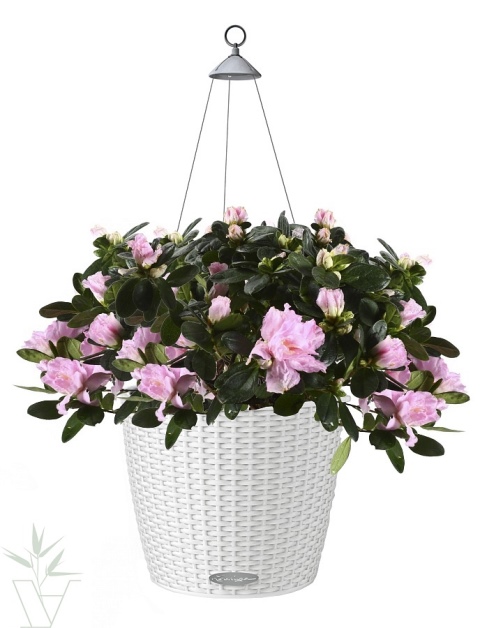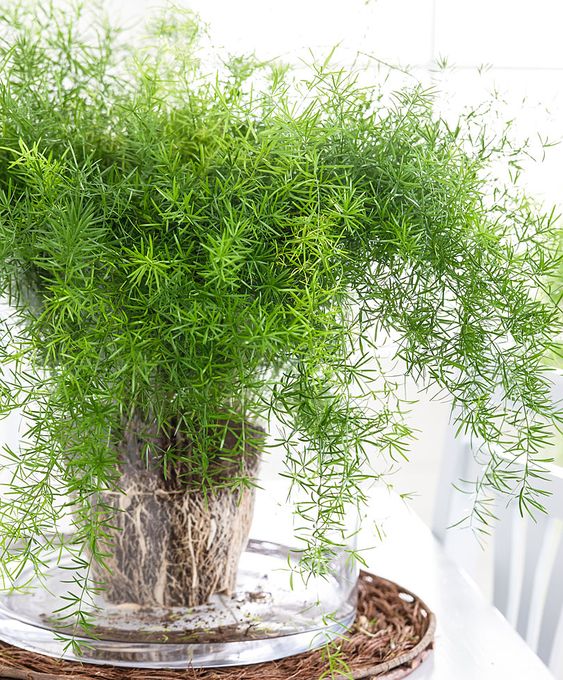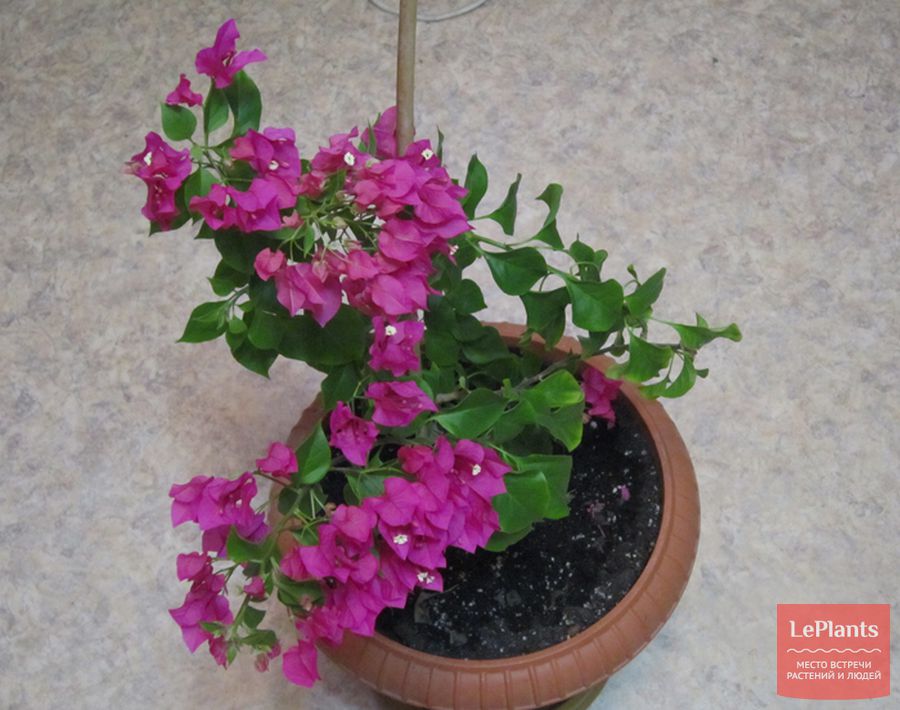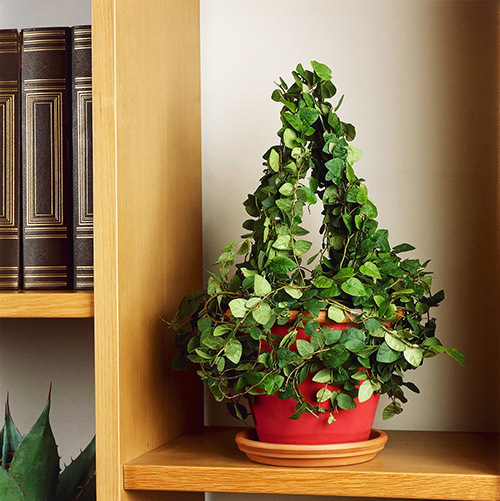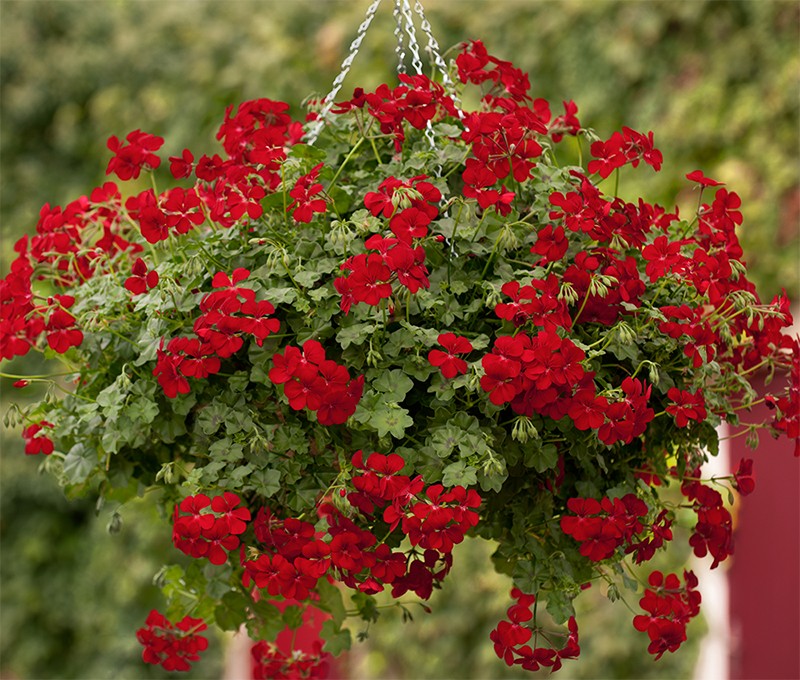Care rules
Basically, ampelous plants need good lighting, at least 4–5 hours a day. In the shade, they lose their decorative effect, stop blooming and have a painful appearance.
Caring for flowers growing in a hanging pot consists of regular watering 1-2 times a week and frequent feeding. To facilitate care, a small piece of peat or coconut fiber is placed in a flowerpot with a flower. They absorb a supply of moisture, which is then gradually given to the flower.
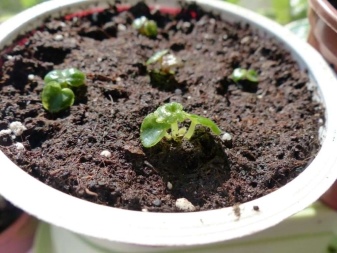

Pruning should be regular. It has a different character: it can be rejuvenating, sanitary or formative. With sanitary pruning, dried flowers and leaves affected by disease or pests are carefully removed. Any kind of plant needs it. The rejuvenating treatment is only suitable for fast-growing plants such as balsams, zebrins and others. When the stems begin to stretch strongly, the base at the root takes on a scanty appearance.
Therefore, after pruning in the spring, leave 5-7 cm from the root. After that, the plant requires special care. It is less often watered, often sprayed and removed from the sun. For the speedy growth of the vegetative mass, mineral or organic fertilizers are applied. Formative pruning is used only when you want to give the plant a special shape.
To create a more decorative look, the plants are planted in a hanging basket. It can be placed on a balcony or porch, in a garden or on a terrace. This will give the flowers the appearance of a plant floating in the air.


When choosing a mount for a hanging pot, keep in mind that the weight of the planter after watering can reach 8 kg. In this case, choose a plastic planter. If you will use painted, galvanized buckets or pots as a hanging pot, then thick ropes or bundles can be used as an attachment.
To decorate a window sill or balcony, you can use long wooden or plastic pots. The plastic ones have a built-in tray for water drainage, and a corresponding container can be substituted under the wooden ones. Under the spreading shoots of ampelous plants of this shape, the pot will be completely invisible.
If you are not going to plant in hanging pots, then you will need a support. After all, such shoots are unable to hold on on their own. Usually, gardeners use arch-shaped posts or stretched threads, possibly using a net.
Bamboo supports are considered the best. They fit harmoniously into the plant pot and are masked by the foliage. Plastic ladders work well to support large vines. For more powerful shoots, plastic-coated metal wire is used.


For an overview of indoor ampelous plants, see below.
Flowering climbing plants
Blooming vines are a separate category of climbing plants that can create a stunning decorative effect.
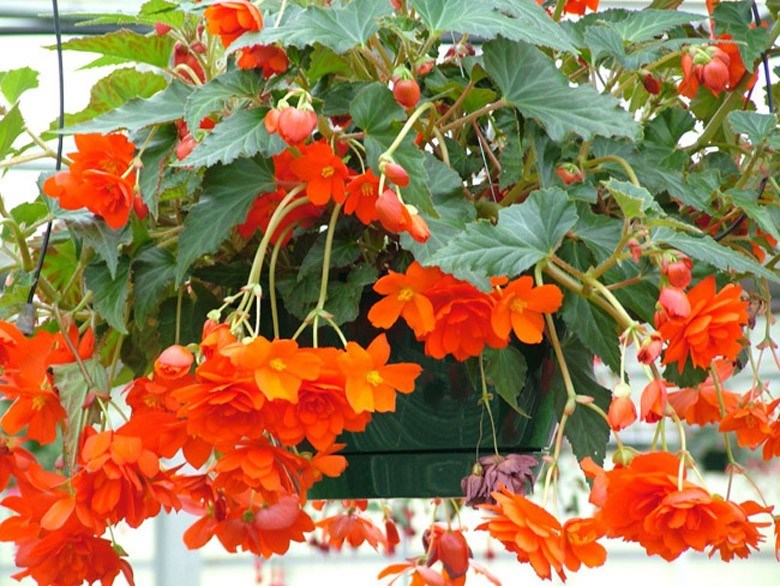
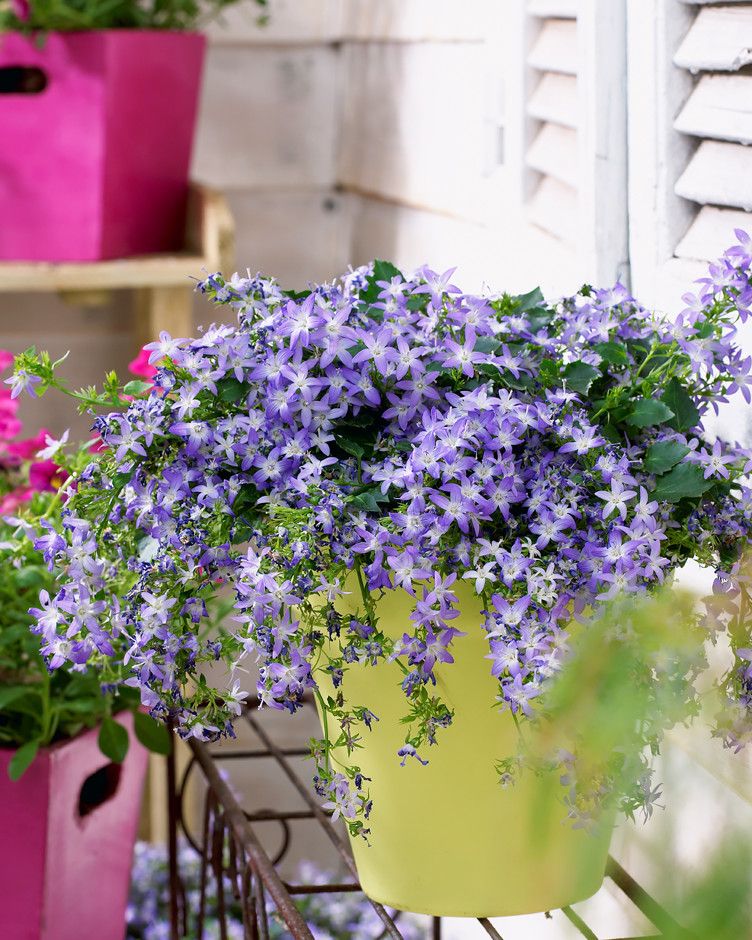
Hoya (Wax ivy)
This indoor vine is adorned with stunning leathery leaves and star-shaped flowers. The maximum possible stem length at home is 3 meters. The advantage of this vine is the long flowering period of several months. With the appearance of the first flower bud, it is recommended not to disturb the plant, not to rotate it or rearrange it. In case of unfavorable conditions, the flower can shed its buds.



If you put the pot on a windowsill on the east or west side, then the leaves on the stem will be especially bright and elastic. During the period of active growth, the flower will require abundant watering. In winter, it is better to limit the access of liquid to the ground. In the warm season, you need to organize feeding with a high percentage of phosphorus.
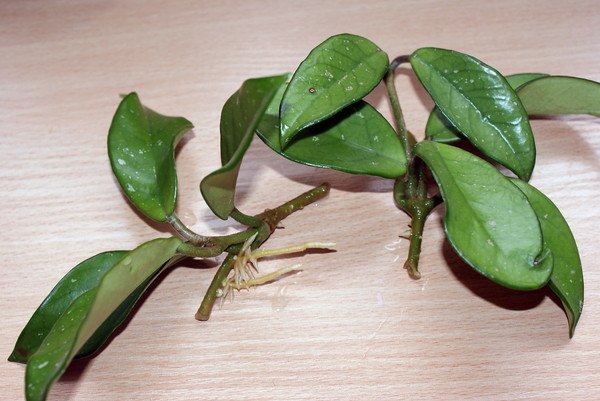


Morning glory tricolor
It is an annual plant when grown in a garden. But for many years it will delight the owner who grows it in the house. Bluish unusual flowers on the vine have the shape of a gramophone. They are evenly scattered over the stem and are able to decorate the room. Flowers and leaves make the vine heavy, so it should be securely supported on a support. In order for the flowering to be lush and long-lasting, dried flowers must be removed.


In the room, the morning glory should be in a well-lit place, but out of direct sunlight. Watering should be abundant and regular. In winter, such a plant should be in a cool place.


Tradescantia
Tradescantia can be called one of the most popular flowering plants, which is found in every second home of amateur flower growers. Liana has a specific appearance: its leaves have a drooping appearance, and the snow-white flowers are fragile and fragile.


A more original variety is Tradescantia Silomantan. Its flowers are purple, like the leaves of the plant themselves. The flower needs a lot of light to grow well. Warm seasons will require regular abundant watering for Tradescantia. In this case, excessive moisture can destroy the flower. Top dressing should be moderate without excess nitrogen.



Each of the described flowers can become a worthy copy of the florist's collection. Lianas in their mass do not require complex care, but they do not tolerate excess water and direct sunlight. The rest of the rules for caring for plants are quite standard.
What climbing indoor plants cannot be kept in an apartment?
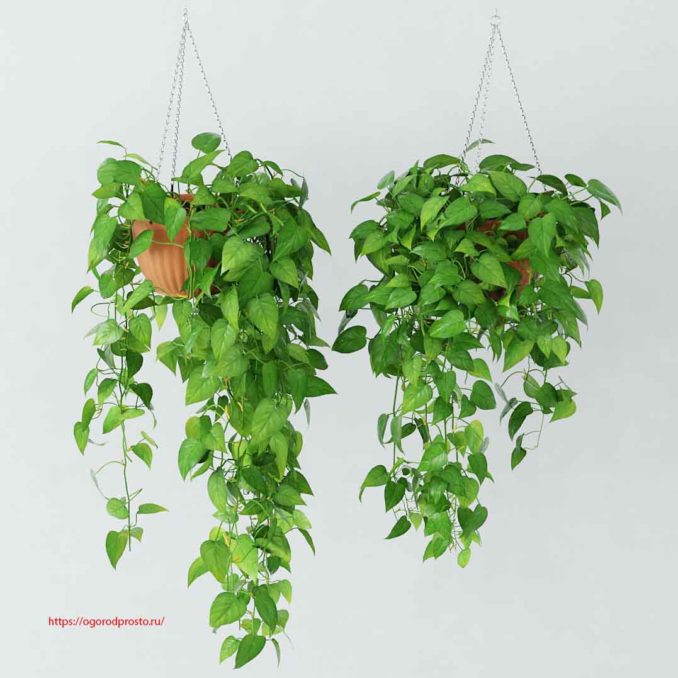
This important question is interesting to many flower growers, especially beginners. There is an opinion that individual climbing vines cannot be kept at home. These include ivy, cisus, and golden mustache. Allegedly, these flowers drive men out of the house. But this opinion is controversial. In Feng Shui, these shade-loving ampelous and ivy-shaped species, on the contrary, improve the atmosphere in the house, protect it from negative energy. Therefore, it is highly recommended to keep them at home. Scientists claim that the plants of this group are excellent air purifiers.
Tradescantia, which also supposedly cannot be kept in the house, is a unique healing plant, a symbol of wealth and family well-being. This plant with increased energy helps to identify any problems in the home associated with emotional stress in family members. If the atmosphere in the house is bad, the plant becomes lethargic, dries up and sheds foliage.
You cannot keep poisonous plants in the house, especially if there are children and animals in the house. For safety reasons, such flowers are placed out of the reach of households and children.
Begonia should be handled with special care. The leaves and stems of the plant contain oxalic acid salts
When in contact with the skin, they cause burns, nausea and vomiting.
Light-loving decorative foliage plants for the home
These plants are prized for the beauty of their leaves.
Their leaf blades, depending on the species, attract attention with an unusual shape or color. All light-loving decorative leafy plants should be kept in good lighting, since otherwise their shoots will stretch out, and the leaves will lose their decorative color.
Let's take a closer look at light-loving decorative leafy indoor plants with their names and photos.
Alocasia
A tropical light-loving plant that requires high humidity and bright lighting. It has a thick rhizome and a modified short stem. Alocasia leaves are arranged on long petioles. The leaf blades are sagittal, with pronounced light veins. The plant reaches a height of 60-70 cm.
Decorative leaf begonia
Deciduous begonias are distinguished by very bright and unusual leaves, as well as inconspicuous flowering. These are very unpretentious indoor plants that need bright light for proper growth.
Usually these are ground cover varieties that have a fairly short and branching stem. Leaves are petiolate, of various shapes and colors. With a lack of lighting, they can lose their color and stretch.
Dracaena
Dracaena is an ornamental light-loving plant, shaped like a palm tree. Its leaves are narrow and long, pointed at the ends. They are mainly concentrated at the ends of straight and powerful shoots.
A plant on its own in a room culture usually does not branch, side shoots can be obtained as a result of pruning the plant. Requires bright lighting, otherwise the shoots grow weak and thin, the leaves dry quickly, and the trunk is bare.
Calathea
A very beautiful and light-loving indoor plant in the shape of a bush. Its trunk is greatly shortened, the leaves grow on long petioles. The leaf blades of the calathea have an oblong shape and a very unusual color. The surface of the leaf is covered with a complex variegated pattern of various shades of green. The leaves resemble bird feathers. Calathea is a capricious plant that can only be grown by experienced flower growers.
Croton
An evergreen shrub that is very popular in indoor culture. It has a straight and branching trunk. Shoots are powerful and straight, covered with leathery leaves of bright color. Croton leaf shape is unique.
It can be from solid to strongly dissected. The color of the leaves is also very varied. They can be painted green, yellow, red, orange and burgundy.
When growing croton, special attention should be paid to lighting. Its deficiency inevitably leads to loss of color and decorative form of the plant.
Monstera
Large houseplant, powerful liana. Its thick shoots reach a length of 1.5 m or more. The leaves are very large and strongly dissected, up to 1 m in diameter. They are attached to the shoot on long stalks. Forms numerous aerial roots for support. In insufficient light, the shoots of the monstera stretch out, and the leaves lose their dissection and become whole.
Syngonium
Syngonium is a perennial vine widely used for landscaping premises. Its shoots can be several meters long. It is also possible to give the syngonium a bushy shape. The leaves of the plant are arrow-shaped or heart-shaped. In length they reach 20 cm. There are many varieties of this species with leaves of a wide variety of colors: white, light green, bright green, pink, reddish.
Growing and caring at home
In order for ampelous cultures to develop normally and please the eye, they must be properly looked after. In addition to regular watering, crops need to be fed, cut off in time in order to remove dead leaves and maintain a neat shape.
Selection of soil and pot
For ampelous crops, it is necessary to create suitable growth conditions. First of all, this concerns the choice of soil and pot. Since ampelous species have long stems, it is best to plant them in pots hanging on the wall. So the shoots of the plant will develop unhindered.

In some cases, you need to take care of the support, especially if you want to decorate the wall beautifully. The planting pot must meet certain requirements:
- Size and shape. Shallow but fairly wide pots work best. Indeed, the root system of most of these plants develops in the surface layers of the soil.
- Colour. Light shades work well, as they don't heat up that much in the sun. Overheating can damage the roots of the plant. It also contributes to acidification of moisture in the soil and the development of fungal diseases that affect the roots.
- Material. Lightweight plastic planters are most suitable. It is more convenient to hang them on the wall. If the plant is supposed to be placed on a windowsill, it is recommended to choose ceramic pots.
As for the choice of soil, it is important to ensure that it is as light as possible.The soil should not contain dense clods, it should be homogeneous. Therefore, the soil is best mixed with sand.
In this case, the roots will grow more easily.
Lighting
The choice of a suitable site is an important condition for the normal growth and development of ampelous. These conditions differ depending on the type
So, succulents, due to their ability to accumulate moisture, thrive in well-lit places.

Most flowering and deciduous varieties require milder conditions. It is better to place them in partial shade. So they will receive the required amount of sunlight without fading from its excess.
Attention! It is believed that flowering varieties with light leaves need more ultraviolet radiation, so it is recommended to place them in more illuminated areas. Ampel species with dark leaves tolerate shaded space better .. Therefore, if a situation arises when a flower turns yellow and withers, it is worth changing its location
Therefore, if a situation arises when the flower turns yellow and withers, it is worth changing its location.
Watering rules
Each flower needs moisture for normal growth. But an excess of it can be as destructive as a lack.

At the same time, the amount of water, the frequency and abundance of irrigation depend on many factors, such as:
- kind of culture;
- season;
- growing conditions.
Succulent plants need to be watered quite rarely, about once every 2 weeks. Decorative deciduous species require more moisture. It is best to water once every 4-5 days. Flowering crops need the most abundant and frequent watering. It is best to water them once every 2-3 days.
Depending on the season, ampelous requires a different amount of moisture. So, in summer and autumn (during flowering) they need to be watered as often as possible. In such conditions, moisture evaporates faster, and more of it is needed for the development of buds.
In the winter season, many ampelous fall into a state of dormancy. All metabolic processes in them slow down significantly, therefore, plants need to be watered less often (succulents are generally not recommended to be moistened). But if the plant blooms all year round, then in winter it needs sufficient moisture. It is best to water the flowers before noon or in the evening.
Reproduction
The most popular method for ampel breeding is cuttings. To grow a new viable plant, you need to choose the right planting material. Young cuttings are well suited for this - shoots with 2-3 buds, from which new stems and leaves will form in the future.

Important! Cutting is best done in late spring or summer. During these periods, the plant is most viable.
The best time for the procedure is early in the morning.
To separate the stalk, you need to choose a suitable shoot and cut it off with a sharp knife. The cut must be carried out at an angle. After that, the cut is sprinkled with well-crushed charcoal, and then placed in a substrate. For this, river sand is usually used, mixed in equal proportions with peat. The substrate must be well moistened. The shoot should be in this mixture until a few strong roots appear. After that, it can be transplanted into the soil.
Ampel perennials
Ampel perennials do not have to be planted every year, but these plants need a warm shelter for the winter. In cold weather, you can bring them into your home.
Perennial flowers for the garden:
- campanula (bell, "bride and groom") are ampelous perennials that bloom all summer;
- Bacopa does not bloom in winter;
- lobelia;
- scovola;
- geranium;
- dichondra.
When preparing a winter shelter, the branches must be removed from the support, laid with a ringlet and covered with spruce branches or insulation.

Verbena
What varieties of ampelous are better to plant on the site
It is advisable to grow beautiful, unpretentious varieties: petunia, lobelia, nasturtium, begonia, pelargonium, etc. They should be chosen not only according to the description, but also according to the characteristics of care and conditions of detention.
How to choose the right plants for your garden
Before planting, you need to decide in what conditions the selected plants will grow. The garden must be visually divided into several zones: the lightest, moderately lit and shaded. Light-loving and shade-loving plants should be planted in different areas. It is also necessary to know in advance how deep the groundwater is.
Important! A responsible grower will not grow flowers if he does not know how to properly care for them.
Ampel plants resistant to direct sunlight
The sun-filled part of the garden is suitable for growing light-loving plants such as:
- surfiniya;
- Moorish bindweed;
- tumbelin;
- fuchsia;
- dichondra;
- geranium;
- spurge;
- feruloliferous succession.

Blooming dichondra
Flowering ampelous plants
Both flowering annuals and perennials are suitable for growing in hanging baskets. Flowers need to be provided with sufficient light, moisture, fertilizer, and periodically trim and pinch them.
If a flower does not have enough light, or, conversely, it suffers from harsh sunlight, then its "relocation" can result in serious difficulties. Hanging flower arrangements are convenient because they can be carried from place to place. Baskets, pots and flowerpots can be hung from the gazebo ceiling or wall.
Flowers such as viola (pansies), petunia, nasturtium, campanula, and pelargonium are distinguished by the greatest decorativeness and variety of species.
Ampel flowers for the garden
In the garden at the summer cottage, flowers in hanging pots, on high flowerpots and even in hedges will look very beautiful.
Additional Information! The name Ampel means "hanging flower vase" in German.
Ampel flowers will decorate the garden and the cottage
Types of ampelous plants
Ampelous garden flowers are divided into three main types:
- Blooming flowers are distinguished by lush and beautiful flowering: petunia, bacopa, fuchsia, pelargonium, lobelia, hoya, columnea, surfiniya, nolana, etc.
- Decorative foliage is distinguished by beautiful leaves that grow quickly and take an interesting shape: ivy, chlorophytum, dichondra, cissus, tradescantia, etc.
- Succulents are low-growing plants with delicate watery leaves: rosewood, erythyllum, ripsalis, sedum, etc.
Magnificent compositions from ampels
Features of ampelous plants and their classification
The most important feature of all ampels is a flexible elastic stem. Ampel street plants are conventionally divided into several varieties:
- Multi-socket - cascading ampels that bloom very brightly and profusely. Designed for hanging planters.
- Creeping - plants with long shoots hanging down. They are grown in hanging pots or tall flowerpots. These pots can be attached to the wall of the gazebo or terrace.
- Creeping plants are low-growing plants that quickly grow in width and cover the lawn, flower bed, garden path, and any other horizontal surface. These plants can be added to the composition, to make a "rug".
- Curly vines are deciduous or flowering vines. They have long branches that grow rapidly, clinging to a support. Climbing plants are used to decorate terraces, roofs, walls of houses or gazebos. Of these, hedges are grown.
- Climbing - the so-called vines that can grow up an arch, wall, fence and any other support.
Surfinia
Benefits of ampelous plants
Ampel plants for the garden have many advantages over other types of flora. Landscape designers always include these flowers in their compositions.
Advantages:
- A wide variety of species and varieties.
- Flowering continues almost all year round.
- An ampel plant can close a defect in a building or garden.
- They make up magnificent flower arrangements - real works of art.
Due to their amazing beauty, ampelous plants are very popular among amateur gardeners and professional decorators.
Lobelia
Fittonia
Perennial undersized plant from South America. This flower loves when it is hotter: 25-26 degrees, but it will feel fine even at +20. The main rule is to avoid sudden changes, otherwise it can lead to stress and the condition of your pet will worsen.

Fittonia loves a well-lit place with diffused light and partial shade. In winter, you can make "supplementary lighting" with fluorescent lamps.
Like any representative of the tropical flora, this flower adores high humidity. So daily watering and pallets of wet expanded clay and pebbles will help the plant feel good. Spray at least once a day and keep away from heating elements. You can transplant Fittonia once a year, while choosing a wide, but shallow pot, since the root system is superficial. You should also remember about good drainage and looseness of the soil. Fittonia blooms from mid-summer to mid-autumn.
Useful articles:
Plants that tolerate light shade and require backlighting
- Brunfelsia (Brunfelsia) - Brunfelsia prefer diffused shade, at the same time it is noted that in the open field culture in a humid climate, some species (B. pauciflora) develop well in the sun and in partial shade;
- Calathea - although calathea are not as whimsical as arrowroots in relation to air humidity, they also prefer high humidity. Also, plants do not tolerate temperature changes well. Ideal placement for kalateas is a closed flower window;
- Cordilina (Cordyline) - a bright place, partial shade, does not tolerate direct sunlight. Many consider cordilina, like dracaena, to be a shade-loving plant, but in fact, in a dark place, it will stagnate and shrink. Intense light is needed for good growth and development. Variegated forms require more lighting than forms with green leaves. If there is enough light in the summer, then in winter the cordilines must be rearranged closer to the window, since in winter there is usually not enough light;
- Privet (Ligustrum) - ligustrum will adapt to any conditions of detention. Ligustrum loves the sun, but grows well in partial shade;
- Arrowroot (Maranta) - leaves have the ability to change their direction: leaf blades under favorable conditions are located almost horizontally, and with a lack of lighting or under other unfavorable conditions, they rise up and fold together;
- Monstera (Monstera) - cannot stand direct sunlight. Many people believe that the monstera is shade-loving and put it in the darkest corner - this is not right. In fact, the monstera is shade-tolerant, and the best place for it is where there is bright but diffused light or light partial shade.
- Large-leaved podocarp, or Large-leaved podocarp (Podocarpus macrophyllus) - withstands shade, although, like any normal plant, it prefers good lighting;
- Peperomia (Peperomia) - species of peperomia with dark green leaves grow in light partial shade, variegated species are more photophilous. In winter, good lighting is required, otherwise the leaves begin to shrink and lose color, so by winter, rearrange the peperomia closer to the window;
- Pittosporum - can tolerate shade, but in this case it blooms worse;
- Syngonium - species of syngonium with dark green leaves tolerate light partial shade, variegated varieties are more light-loving;
- Capitate yew (Cephalotaxus) is an evergreen columnar shrub, strictly vertical, slightly branched, with very densely arranged branches, more funnel-shaped or round-barrel-shaped with age, resembles a dark green, columnar yew with coarse scales; grows slowly;
- Fatsia - tolerates partial shade, requires good lighting in winter;
- Philodendron (Philodendron) - representatives of the genus are vines climbing, creeping, with woody or semi-herbaceous branches and shoots, as well as with long aerial roots;
- Hamedorea, or "bamboo palm" (Chamaedorea) - prefers bright diffused light, tolerates some shading. It can tolerate a small amount of direct sunlight; in summer, the palm tree is shaded from them;
- Cissus (Cissus) - Antarctic and multicolored cissus do not tolerate direct sun and can grow in a shaded place, but a place near the east or west window is especially good for them;
- Eucharis (Eucharis) - during flowering - a wonderful specimen plant that can decorate the shelves in the office, bookshelves in the office, bedside table, coffee table and even a bathroom (of course, with a window). During dormant periods, its luscious, dark green leaves make the perfect backdrop for a potted plant arrangement. In the winter garden, eucharis is best placed under the canopy of large plants;
- Ficus (Ficus) - stable in indoor conditions, suitable for residential and office buildings, winter gardens. Ficuses are very beautiful in the interior. Climbing and creeping are effective in hanging ceramic vases. They grow quickly, relatively not demanding on light.
Indoor plants growing in low light conditions. easyfeeding
I would be glad if you also share your experience, observations about those plants that could be grown in shaded areas of apartments.
Care rules
Temperature
The main percentage of climbing crops comes from the hot tropics, which is why loaches love warm climates with high humidity so much. But frosts are very poorly tolerated by lianas.
It is important to ensure that in winter the temperature does not drop below 16 degrees, and in summer it does not exceed 21 degrees. If the heater or air conditioner is turned on, do not do it near the flower
Lighting
Most varieties of indoor vines thrive in light partial shade. Flowers can get noticeable burns in direct sunlight. From time to time, flowerpots and pots with vines need to be turned. This is to ensure that the pet receives sufficient light from all directions. Otherwise, the vine runs the risk of stretching in one direction and remaining deformed.
Climbing houseplants need regular watering and spraying. You can save a flower from hot weather if you use cool water and moisturize the planting at least a couple of times a day. It is advisable to water the vines either in the morning or in the evening. In the middle of the day, when the sun is especially active, it is better not to do this.
Watering the flowerpot should be carried out in the course of drying the soil in it.
Like most other types of indoor plants, climbing vines cannot be left without high-quality and suitable fertilizers. For such green pets, fertile and light soil or special ready-made soil mixtures consisting of suitable components are ideal. The faster the culture grows and develops, the more it will need good feeding. Due to the timely application of fertilizers, the foliage will be more juicy, thick and lush.
Safe mineral dressings are ideal for indoor vines. You can also use high-quality organic matter, previously diluted with water. Each grower chooses the fertilizer for his plantings. The main thing is not to neglect feeding if you want the loach to grow lush and healthy.
Pruning
Pruning of these beautiful plants should not be relegated to the background. The specified procedure is necessary for vines so that they always maintain a beautiful, neat and well-groomed appearance. The crop should be properly positioned on the chosen support bases and carefully trimmed from time to time.
So that the branch located in the center grows long and strong, it will need to be gradually braided around a round support, and then carefully but securely fixed
If you want the loach to grow fluffy and voluminous, new branches are pinched to the apical shoot. In this way, the processes are formed on the sides.
But there are also some basic procedures that determine watering, feeding and caring for a vine, because its appearance, as well as health, largely depends on this. First, it is necessary to properly organize individual care for the vine, take into account the characteristics of the variety. In order to avoid the most common mistakes, you can draw up a schedule that will reflect the scheme for watering and feeding the vines, as well as its pruning and growth rate.
Also, in an individual approach, pruning creepers is very important. It is usually carried out only in case of urgent need, as well as in accordance with individual recommendations and pruning techniques for each individual variety. The same applies to the schedule of watering, transplanting or feeding, since each variety is purely individual, and the plant also individually perceives the basic care procedures.




